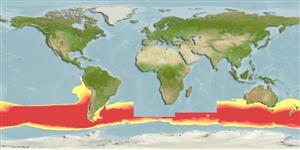Teleostei (teleosts) >
Argentiniformes (Marine smelts) >
Microstomatidae (Pencil smelts)
Etymology: antarctica: Named for its region of occurrence.
Eponymy: Fridtjof Nansen (1861–1930) was a Norwegian explorer, scientist, diplomat and later recipient of the Nobel Peace Prize. [...] (Ref. 128868), visit book page.
Environment: milieu / climate zone / depth range / distribution range
Ecology
Marine; bathypelagic; depth range 0 - 4145 m (Ref. 58018). Temperate
Southern Ocean: circum-Antarctic in sub-Antarctic water.
Size / Weight / Age
Maturity: Lm ? range ? - ? cm
Max length : 22.0 cm SL male/unsexed; (Ref. 5001)
Short description
Identification keys | Morphology | Morphometrics
The largest specimen studied, 20.75 cm SL had matured ovaries with developing eggs (Ref. 5123).
Life cycle and mating behavior
Maturity | Reproduction | Spawning | Eggs | Fecundity | Larvae
Gon, O., 1990. Microstomatidae. p. 105-106. In O. Gon and P.C. Heemstra (eds.) Fishes of the Southern Ocean. J.L.B. Smith Institute of Ichthyology, Grahamstown, South Africa. 462 p. (Ref. 5001)
IUCN Red List Status (Ref. 130435: Version 2024-1)
Threat to humans
Harmless
Human uses
Tools
Special reports
Download XML
Internet sources
Estimates based on models
Preferred temperature (Ref.
123201): 1.7 - 6.4, mean 2.8 °C (based on 679 cells).
Phylogenetic diversity index (Ref.
82804): PD
50 = 0.5000 [Uniqueness, from 0.5 = low to 2.0 = high].
Bayesian length-weight: a=0.00389 (0.00180 - 0.00842), b=3.12 (2.94 - 3.30), in cm total length, based on all LWR estimates for this body shape (Ref.
93245).
Trophic level (Ref.
69278): 3.3 ±0.4 se; based on size and trophs of closest relatives
Fishing Vulnerability (Ref.
59153): Low vulnerability (17 of 100).
